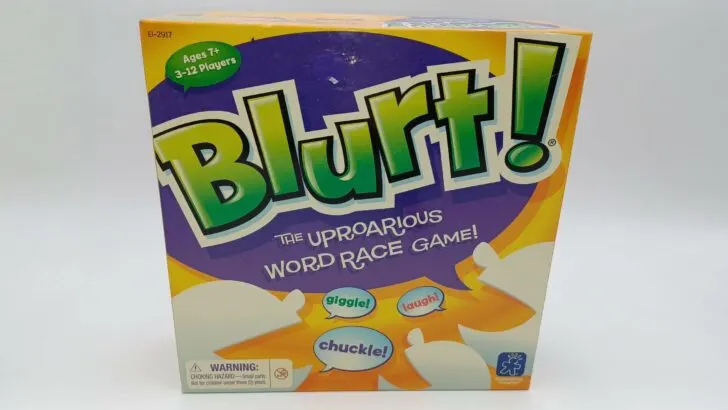Objective of Blurt!
The objective of Blurt! is to be the first player/team to move your playing piece around the gameboard.
Note: There have been some minor changes to the rules over the years. I will note below the differences between versions.
Setup
- Players decide whether they are going to play by themselves or on teams. Each player/team chooses a color pawn. In the normal game players should only choose from the green, orange, purple and red playing pieces. The other pieces are used in the junior version of the game.
- Place the gameboard in the middle of the table. Each player/team places their playing piece on the start (!) space.
- Set the card box on the table where everyone can reach it. Players should draw cards from the draw side of the box and discard cards to the discard side.
- The players need to decide which side of the cards they will use during the game. In newer versions of the game, the side with the stars at the top are easier. In older versions of the game, the blue side is easier.
- All of the players/teams roll the dice. The player that rolls the highest number starts the game as the first reader.
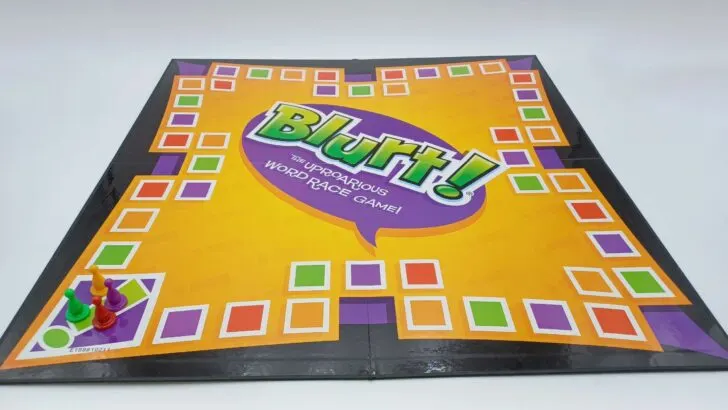
Playing Blurt!
The reader begins each turn by drawing a card and holding it so the chosen side if visible. They will then roll the die.
The number they roll on the die determines which word will be used during the round. The number you roll corresponds to a word on the card. In newer versions of the game there are three words and the numbers on the left side indicate what words each number corresponds to. In older versions of the game there are two words. Numbers 1-3 correspond to the top word, and 4-6 correspond to the bottom word.
Once the reader knows what word will be used this round, they will read out the corresponding clue/definition for the word.
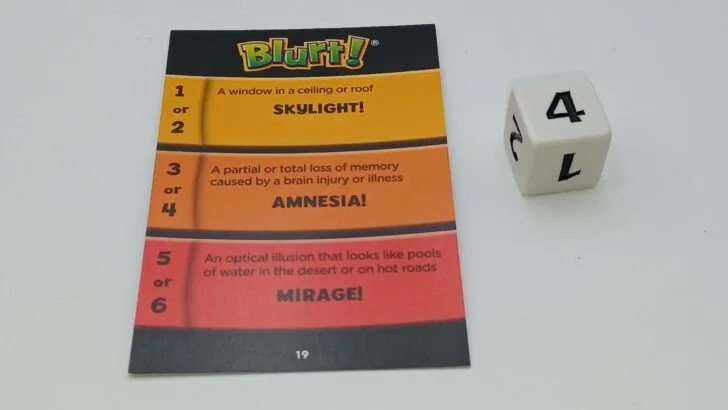
Once the reader starts reading out the clue, all of the other players can start to say answers. If the reader is on a team, none of their teammates can guess this round. You can make as many guesses as you want as there is no punishment for incorrect answers.
Guessing the Correct Answer
The current turn ends whenever a player guesses the correct word. The first player to say the correct word wins the turn.
If multiple players answer correctly, the reader determines who answered first. If it is not possible to determine who answered first, all of the players who answered correctly play another word. The reader draws a new card and reads the clue corresponding to the number that was rolled. Whichever tied player from the previous word answers correctly first wins the turn.
The winner of the turn moves their pawn forward a number of spaces equal to the number rolled on the die.
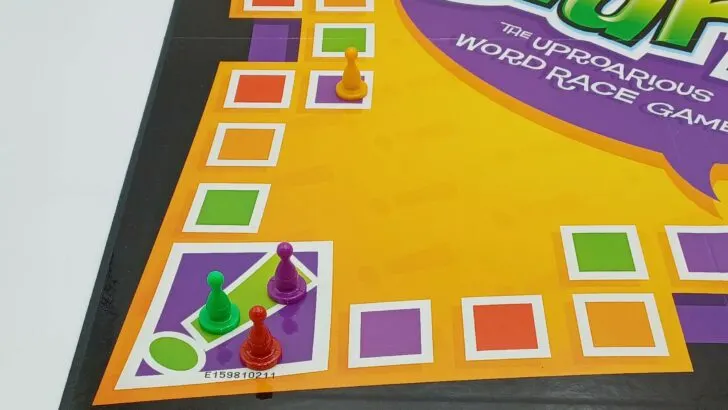
If no one can figure out the word on the card, the turn ends with no one getting to move their pawn.
At the end of the turn, the card box is passed clockwise to the next player. That player becomes the reader for the next turn.
One-on-One Showdowns
Should your pawn ever land on a space that already has a pawn on it, you will challenge the other player/team that is already on the space. A neutral player becomes the reader for the challenge.
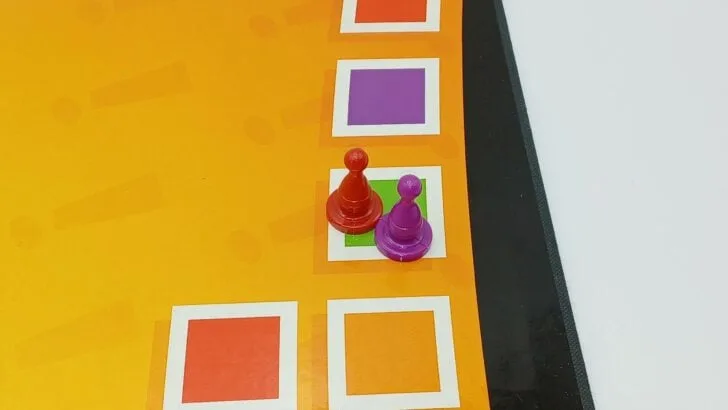
The reader chooses one of the words on the card they draw and reads out its definition.
Both players/teams try to be the first to provide the correct answer. You can shout out as many answers as you want as there is no punishment for incorrect answers.
If the challenger (the player who landed on the occupied space) is the first to come up with the correct answer, they win the challenge. The pawn that previously occupied the space moves their pawn back to the space that the challenger moved their pawn from. Basically they move their pawn back spaces equal to the last die roll.
If the player whose pawn was previously on the space wins the challenger, the challenger returns their pawn to the space they were on before moving.
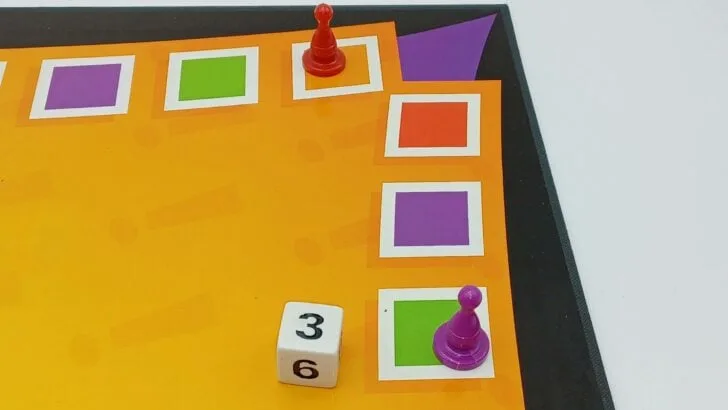
After the challenge is completed, the game returns to the normal gameplay. The next player clockwise (from before the challenge) becomes the next reader and another turn is played.
Color-Coded One-on-One Takeover
If after moving your pawn you land on a space that matches the color of your pawn, you can attempt a takeover. You may choose another player/team that is ahead of you on the gameboard to challenge. This is not required as you can choose not to try a takeover.
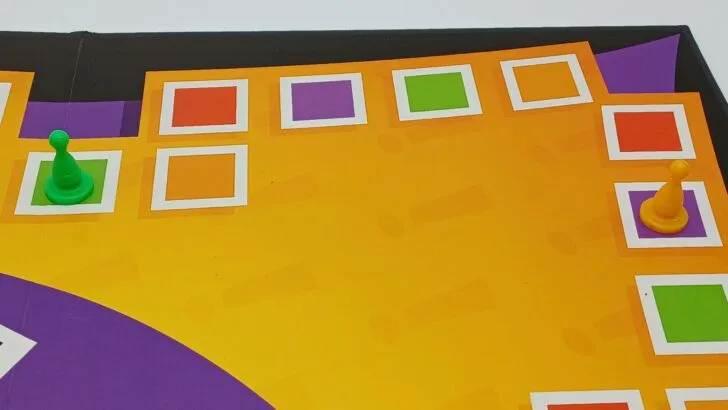
A neutral player is chosen as the reader and they draw a card. They choose one of the words and reads the clue.
Both players/teams in the takeover try to say the answer first. There is no punishment for incorrect answers.
If the challenger answers correctly first, the two players/teams swap the position of their pawns.
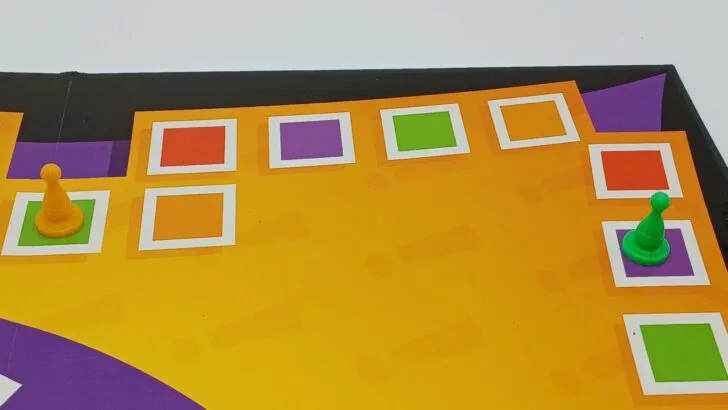
Should the challenged player/team answer correctly first, both pawns remain on their current spaces.
Winning Blurt!
To win Blurt! you need to move your playing piece around the entire gameboard. The first player/team to move their playing piece around the entire board and back to the start space wins the game. You do not need to land on the start space by exact count.
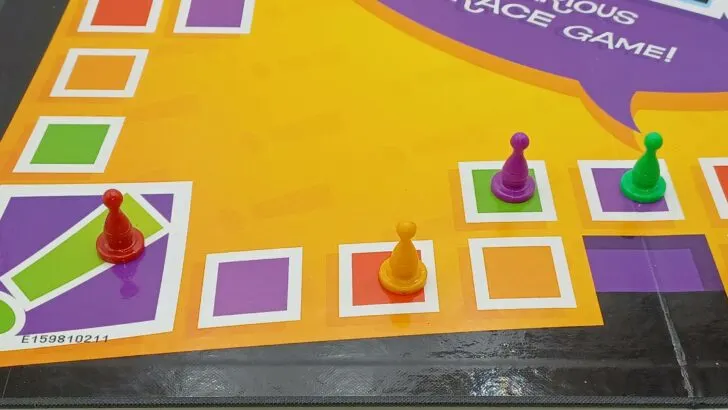
Advanced Rules
If you want to play a more challenging version of Blurt!, you can decide to use the advanced rules. There are two different rules that you can choose to use while playing the game. You can choose to use both rules, or only one of the rules.
First you can choose to let each player/team only give one answer each turn. If you give a wrong answer, you cannot provide anymore answers for the current turn.
The other rule only applies when a six is rolled. The reader counts up the number of words in the clue and tells the other players the number. The players then bid on how many words they need from the clue in order to guess the word. The players keep bidding a lower number of words until no one wants to lower the bid. The player/team that bids the lowest is the only team that can guess during the rest of the turn.
The reader then reads a number of words from the clue equal to the lowest bid.
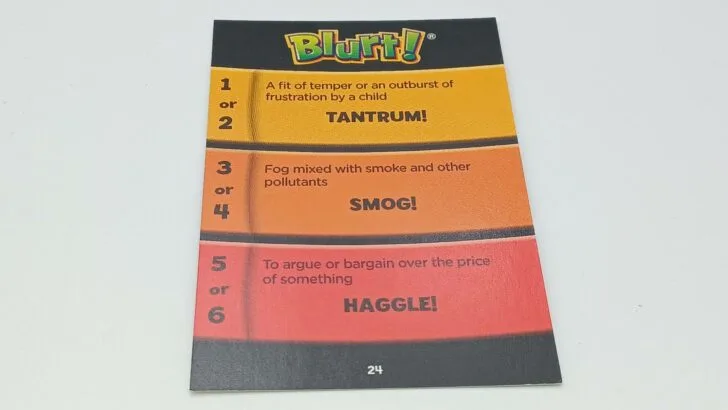
If the player/team correctly guess the word, they move forward six spaces. If they don’t guess the right word, they move their pawn back six spaces.
Blurt! Junior
Blurt! Junior is played similar to the main game with a couple of changes.
You can use any color of pawn. An adult should be the reader every turn and should read from the easier side of the cards. They should read the first word on the card. If you want to make the game easier for younger players you can choose to say the first letter from the word in addition to the clue.
Instead of blurting out answers, each player/team should write down their answer. Players should try to spell the word correctly as they can score more points.
Scoring
When everyone has written down an answer, the reader checks each players’/teams’ answer. Players will gain spaces as follows:
- If you wrote down the right word and spelled it correctly, you move your pawn forward four spaces.
- If you wrote down the right word but you misspelled it, you move your pawn forward three spaces.
- Should you write down the wrong answer, you don’t get to move your pawn forward any spaces.
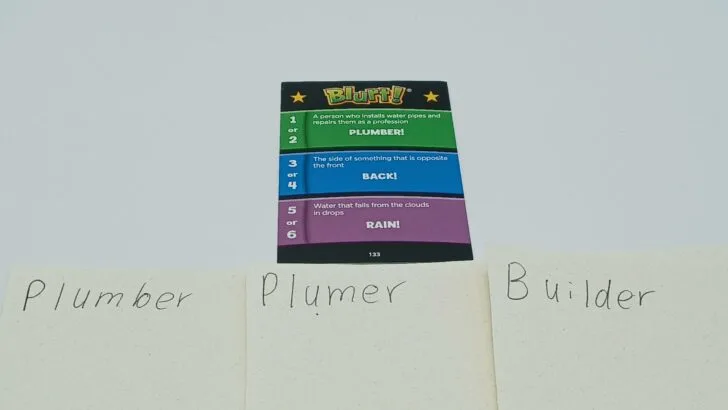
Winning
The first player to move their pawn back to the start space wins the game.
If there is a tie, breaking the tie depends on what version of the game you have. In newer versions of the game, the player/team with less spelling mistakes during the game wins. In older versions of the game, the tied players/teams play another round. The first team to blurt out the correct word wins the game.
Blurt! FAQs
If you have any questions about how to play Blurt!, leave a comment below on this post. I will try to answer any questions asked as best and as quickly as possible.
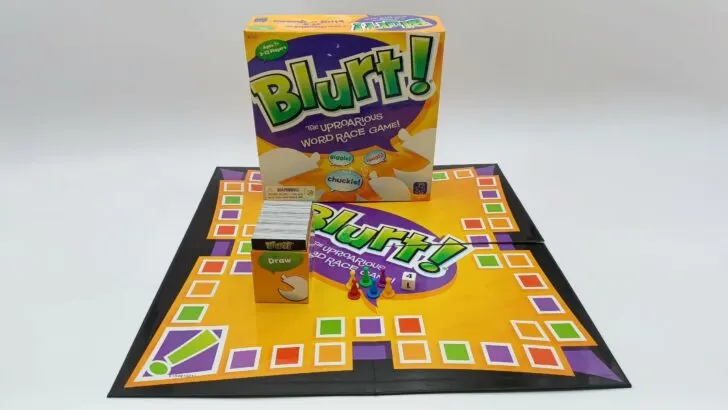
Components
- 300 cards
- 6 pawns
- Die
- Gameboard
- Instructions
Year: 1992 | Publisher: Educational Insights, Mattel, Patch Products | Designer: Tim Walsh
Genres: Party, Trivia, Word
Ages: 7+ | Number of Players: 3-12 | Length of Game: 60 minutes
Difficulty: Light | Strategy: Light | Luck: Moderate
For more board and card game how to plays/rules and reviews, check out our complete alphabetical list of board game posts.

